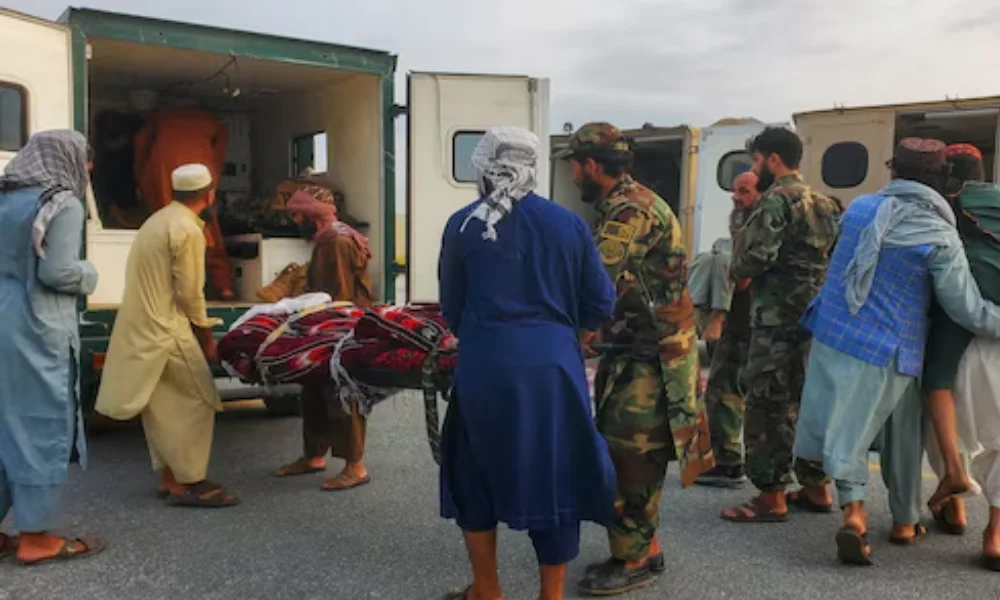Over 600 Killed in 6.3 Magnitude Afghanistan Earthquake

Over 600 Killed in 6.3 Magnitude Earthquake in Afghanistan, Rescue Operations Underway
A devastating 6.3 magnitude earthquake struck eastern Afghanistan near Jalalabad in Nangarhar province on Monday, September 1, 2025, claiming over 600 lives and injuring at least 400 people, according to official reports. The powerful tremors, which were felt as far as Pakistan and northern India, have triggered urgent rescue operations to locate survivors trapped under collapsed structures in the rugged and remote terrain of the Hindu Kush region.
Rising Death Toll and Ongoing Rescue Efforts
The earthquake, which struck at 11:47 pm local time, has left a trail of destruction in Afghanistan’s eastern provinces, particularly in Kunar and Nangarhar. Initial reports confirmed 250 fatalities, which was later revised to 500 by the state-run broadcaster Radio Television Afghanistan (RTA). However, the Taliban-run Afghan interior ministry has now confirmed a death toll of 622, with expectations that the number could rise further as rescue teams reach remote areas. "The number of casualties and injuries is high, but since the area is difficult to access, our teams are still on site," said Sharafat Zaman, spokesperson for the Afghan health ministry.
Rescue operations are in full swing, with helicopters airlifting the injured to hospitals in Jalalabad and other nearby areas. The mountainous terrain, coupled with landslides triggered by the quake, has made it challenging for rescue teams to access affected villages. Many homes, constructed from mud and stone, were reduced to rubble, complicating efforts to locate survivors. Images from the scene show residents and soldiers working together to carry victims to ambulances, highlighting the urgency of the situation.
Details of the Earthquake and Aftershocks
According to the United States Geological Survey (USGS), the 6.3 magnitude earthquake struck approximately 27 kilometers northeast of Jalalabad, a major city in Nangarhar province with a population of nearly 200,000. The quake occurred at a shallow depth of 8 to 10 kilometers, which amplified its destructive impact. Shallow earthquakes tend to cause more damage due to the proximity of the seismic waves to the surface, leading to widespread destruction of poorly constructed buildings.
Following the initial tremor, a 4.7 magnitude aftershock struck at a depth of around 140 kilometers, not far from the epicenter. Additional aftershocks, including a 5.2 magnitude quake, were reported in the hours that followed, further complicating rescue efforts. The tremors were felt across eastern Afghanistan, including the districts of Nur Gul, Soki, Watpur, Manogi, and Chapadare, as well as in parts of Pakistan, such as Islamabad and Khyber Pakhtunkhwa, approximately 370 kilometers away.
Deadliest Earthquake Since 2023
This earthquake marks the deadliest natural disaster to strike Afghanistan since October 2023, when a 6.3 magnitude quake and its aftershocks claimed between 1,500 and 4,000 lives, according to varying estimates from the United Nations and the Taliban government. The 2023 earthquake, centered in Herat province, highlighted the vulnerability of Afghanistan’s infrastructure to seismic activity, a recurring challenge in the region due to its location at the junction of the Indian and Eurasian tectonic plates in the Hindu Kush mountain range.
Afghanistan’s susceptibility to earthquakes is well-documented, with the Hindu Kush region being particularly prone to seismic events. The collision of tectonic plates in this area creates frequent and often devastating earthquakes, which are exacerbated by the country’s fragile infrastructure. Many homes in rural areas, constructed from mud and stone, are ill-equipped to withstand such tremors, leading to high casualty rates and widespread destruction.

Challenges in Rescue and Relief Operations
The remote and mountainous terrain of eastern Afghanistan has posed significant challenges to rescue operations. Landslides triggered by the earthquake have blocked roads, forcing authorities to rely heavily on helicopters to evacuate the injured and deliver aid. The Taliban government has appealed for urgent assistance from international aid organizations, with the Red Cross and other agencies distributing relief materials such as water, shelter, and food to affected communities.
"The short-term needs are water, shelter, and food," said Alexander Matheou, IFRC regional director for Asia Pacific. The destruction of entire villages, particularly in Kunar province, has left hundreds of families homeless, adding to the complexity of the humanitarian response. Hospitals in Jalalabad and Kunar are overwhelmed with the influx of injured victims, many of whom require immediate medical attention.
Impact on Afghanistan’s Humanitarian Crisis
The earthquake comes at a particularly challenging time for Afghanistan, one of the world’s poorest countries, which is already grappling with multiple humanitarian crises. The nation has been reeling from four consecutive years of drought and the recent return of over 2.3 million Afghans from Iran and Pakistan. Additionally, flash floods in Nangarhar and Kunar provinces between Friday and Saturday claimed at least five lives and destroyed crops and property, further straining the country’s limited resources.
The combination of natural disasters and ongoing economic challenges has exacerbated Afghanistan’s vulnerability. The lack of modern infrastructure and limited access to remote areas make it difficult to provide timely aid and support to affected communities. The international community’s response will be critical in addressing the immediate needs of survivors and supporting long-term recovery efforts.
Regional and Global Implications
The earthquake’s impact extended beyond Afghanistan, with tremors felt in Pakistan’s Khyber Pakhtunkhwa and Punjab provinces, as well as in northern India, including Delhi-NCR. The widespread reach of the seismic activity underscores the interconnected nature of the region’s geology and the need for coordinated disaster preparedness and response strategies. The USGS issued an orange alert, indicating significant casualties and widespread damage, necessitating a regional or national-level response.
Afghanistan’s position on active fault lines, particularly in the Hindu Kush, makes it prone to recurring earthquakes. The 2022 earthquake in eastern Afghanistan, which killed around 1,000 people, and the 2023 Herat earthquake serve as grim reminders of the country’s vulnerability to natural disasters. Each major quake further strains Afghanistan’s reconstruction efforts, which are already hampered by decades of conflict and economic instability.
Comment / Reply From
No comments yet. Be the first to comment!











